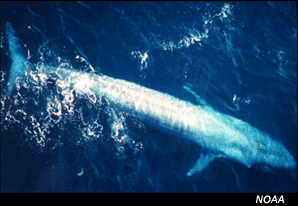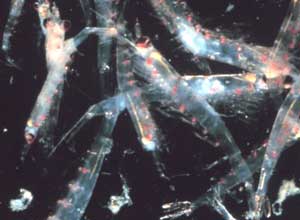Blue Whales are True Giants
Imagine if you were sailing the ocean for the first time, venturing into a place you'd never seen before, and you look over the side of your boat into the water and see the creature in the photo at left. Imagine that you know almost nothing about what lives in the sea, or what to expect from any creatures you might see. This strange creature swimming near the surface is longer than the ship you are sailing on. You might be a little scared, especially having never seen it before and not knowing what it is capable of. You might even be worrying about whether this creature eats humans. The sheer size of it makes you wonder if it can capsize your ship in pursuit of a meal. But you have nothing to fear for this enormous animal is merely a whale.
For many, many years ancient sailors had rare encounters with these gigantic ocean mammals and were terrified by their overwhelming size and powerful tails. You can understand a little of the fear and trepidation they might have felt upon seeing these huge, mysterious creatures for the first time. Today we know them to be virtually harmless to humans and that they have quite a bit in common with us – they, too are warm-blooded mammals that must breathe air. They are highly social animals with complex languages and intelligence. Most importantly, they are not monsters at all, but gentle giants we’ve come to respect, admire and protect.
 Gentle Giants
Gentle Giants
In scary movies the gigantic creature that swims in the ocean, or the huge beast that roams the streets, are evil monsters bent on harm and destruction. But in nature (in real life), the very largest of the large creatures have been virtually harmless to humans. In fact, magnificent creatures such as the great blue whale have suffered most at the hands of humans bent on destruction. Blue whales, as well as many other whale species, have been hunted to the brink of extinction by people from all over the world for centuries. It's only recently, in this century, that we as a species have begun to appreciate the value of all living creatures. We have come to feel that wiping any species of animal off the face of the earth forever is an evil thing for humans to do. Blue whales have been put on the United States' endangered species list. Whalers in the 19th and 20th centuries hunted this giant nearly to extinction, killing as many as 29,000 in 1931, probably the peak year.
Big in Every Way
Blue whales are so big they are the BIGGEST creature ever to have lived on earth - even bigger than the biggest dinosaurs! The LARGEST whale ever measured was a female weighing 171,000 kgs and measuring over 90ft./27m long. The LONGEST whale measured in at over 110ft./33m. If you laid him out on the ground he would take up the length of nine family-sized cars!
Blue whales diet consists mainly of krill, a tiny shrimp that lives in tremendously large schools in almost every ocean of the world. Krill is probably one of the most plentiful food species (outside of insects) anywhere on earth. It's gotta be to keep up with the blue whales' big appetite. A big blue can eat over a thousand krill at one time swallowing them with a tongue that weighs as much as an elephant! Blue whales eat the krill using a special type of filter on their mouths called a baleen. By gulping enormous amounts of sea water containing the live krill the blue whale closes its mouth and flushes the sea water back out through the filter leaving the krill behind for it to swallow. Small fish and plankton are also favorite food items of the whale. It takes about 8,000 lbs/3600kg of fresh seafood a day to keep the blue whale well fed.
 Probably the most spectacular thing about blue whales that's bigger than big is the sounds they make. If you have speakers on your computer you can listen to a recording of "blue whale speech" by clicking on the 'play' button in the audio box above. Scientists have measured the low-frequency (deep rumbling) sounds they make when they communicate with each other by using a decibel meter. Some of their vocalizations have been recorded as loud as 188 decibels and can be heard as far as 530 mi/848km away. To give you an idea of just how loud 188 decibels is a commercial jet taking off makes a sound of 120 decibels. That makes whales, by far, the loudest living
Probably the most spectacular thing about blue whales that's bigger than big is the sounds they make. If you have speakers on your computer you can listen to a recording of "blue whale speech" by clicking on the 'play' button in the audio box above. Scientists have measured the low-frequency (deep rumbling) sounds they make when they communicate with each other by using a decibel meter. Some of their vocalizations have been recorded as loud as 188 decibels and can be heard as far as 530 mi/848km away. To give you an idea of just how loud 188 decibels is a commercial jet taking off makes a sound of 120 decibels. That makes whales, by far, the loudest living
Why is the Blue Whale So Big?
Scientist don't really know for sure, but they are sure of one thing - as big as the ancient dinosaurs were they were NEVER as big as the blue whale is. The blue whale is the largest creature to have ever lived on earth! One of the most important reasons that whales have become so large is they have more SPACE - more room to roam. Remember: over 70% of the earth is covered in ocean water.
Another nice thing about living in the oceans, besides all the real estate, is the weightlessness effect of water. If you like to swim or SCUBA dive you know how it feels to be in the water - almost like floating in space. (In fact, NASA sometimes trains their astronauts inside huge tanks of water to get familiar with working in a zero-gravity environment.) It's the weightlessness of the ocean environment that allows a whale to maintain such huge proportions. Instead of relying on a skeleton to support the weight of its massive bulk the buoyancy of the surrounding ocean water supports the weight of the whale's body tissues. If a blue whale were to be removed from the ocean it would smother under its own weight - a result of the effects of gravity.
No comments:
Post a Comment